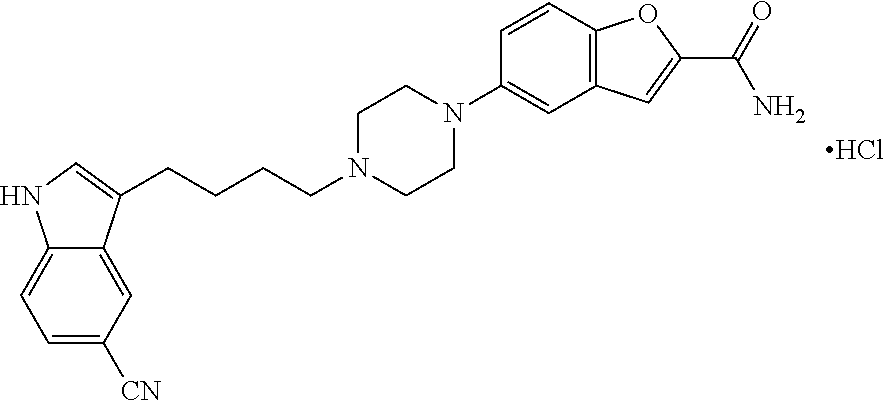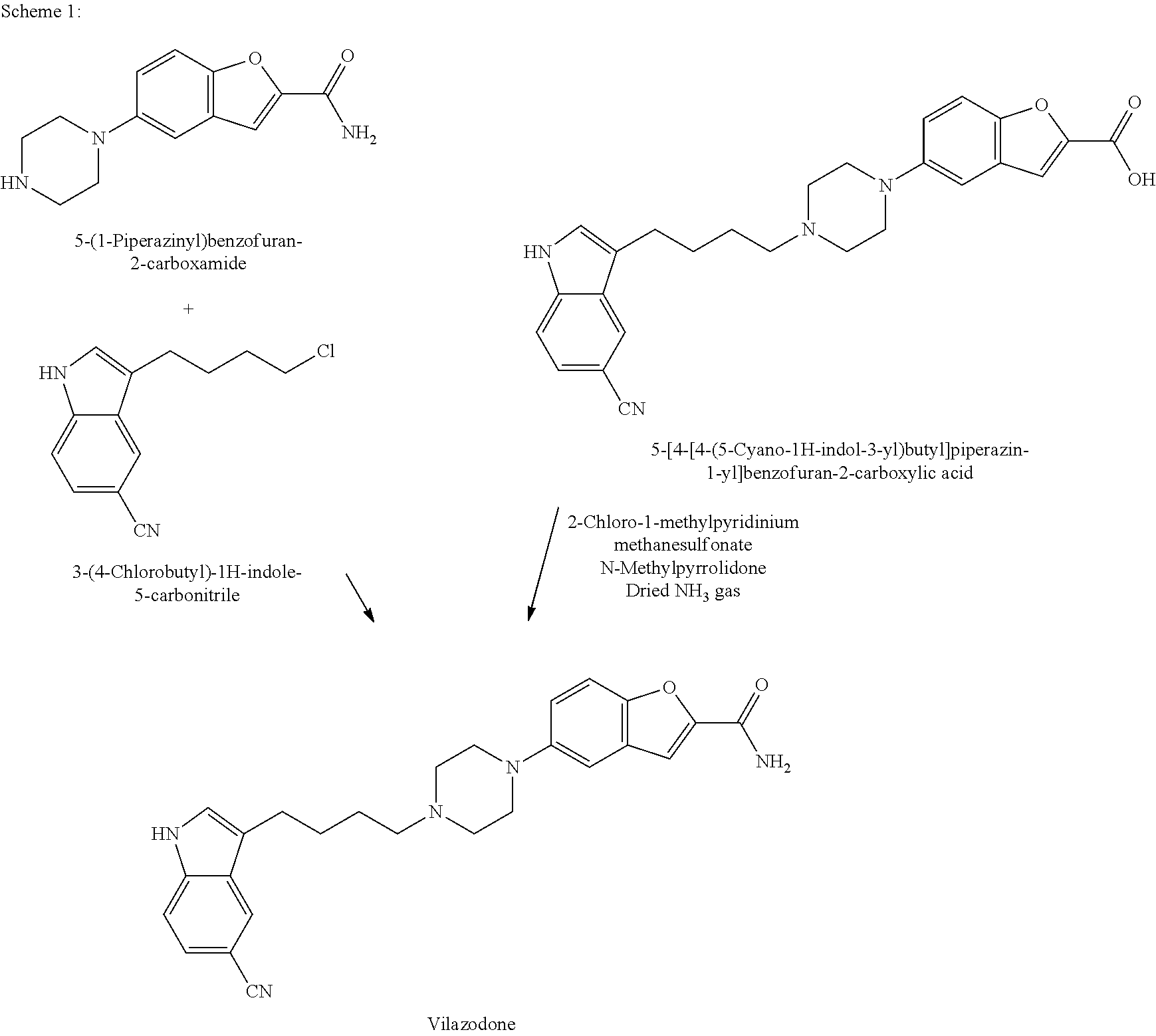Improved process for preparing benzofuran-2-carboxamide derivatives
a technology of benzofuran and carboxamide, which is applied in the field of improved process for preparing benzofuran-2-carboxamide derivatives, and achieves the effect of high purity and high yield
- Summary
- Abstract
- Description
- Claims
- Application Information
AI Technical Summary
Benefits of technology
Problems solved by technology
Method used
Image
Examples
example 1
Preparation of 5-(1-Piperazinyl)benzofuran-2-carboxamide
Step-1: Preparation of Methyl 5-[4-(Benzenesulfonyl)-1-piperazinyl]benzofuran-2-carboxylate
[0196]Methyl 5-aminobenzofuran-2-carboxylate (200 g) and N-benzenesulfonyl-N,N-bis(2-chloroethyl)amine (289 g) were added to tributyl amine (1012 ml) under stirring at 25-30° C. The resulting mixture was heated to 73-77° C., followed by stirring for 43 hours at the same temperature. The reaction mass was cooled to 25-30° C., followed by the addition of methanol (506 ml) and then stirring for 30 minutes at 25-30° C. The resulting mass was filtered, washed with chilled methanol (200 ml) and then dried to produce 220 g of methyl 5-[4-(benzenesulfonyl)-1-piperazinyl]benzofuran-2-carboxylate as a fine powder (Purity by HPLC: 99.5%).
Step-2: Preparation of Methyl 5-(1-piperazinyl)benzofuran-2-carboxylate
Method A:
[0197]Methyl 5-[4-(benzenesulfonyl)-1-piperazinyl]benzofuran-2-carboxylate (10 g) was added to sulfuric acid (25 g) at 25-30° C. and th...
example 2
Preparation of Methyl 5-[4-[4-(5-cyanoindol-3-yl)butyl]piperazin-1-yl]benzofuran-2-carboxylate
Step-1: Preparation of 3-(4-Hydroxybutyryl)-1H-indole-5-carbonitrile
[0200]Aluminium chloride (82.44 g) was added to dichloromethane (350 ml) under stirring at 25-30° C. The resulting mass was cooled to 0-5° C., followed by drop-wise addition of 4-chlorobutyryl chloride (87.5 g) for 30-45 minutes at 0° C. and then stirring for 5 minutes at the same temperature. A solution of 5-cyanoindole (50 g) in dichloromethane (350 ml) was added drop-wise to the resulting mass at 0-5° C. within 1-2 hours, followed by stirring for 30 minutes at the same temperature. The temperature of the reaction mass was gradually increased to 25-30° C., followed by stirring for 12-16 hours at the same temperature. The reaction mass was slowly poured into crushed ice (420 g) with slow stirring, the resulting mixture was cooled to 0-5° C. and then stirred for 1 hour at the same temperature. The separated solid was filter...
example 3
Preparation of 3-(4-Chlorobutyl)-1H-indole-5-carbonitrile
Step-1: Preparation of 3-(4-Chlorobutyryl)-1H-indole-5-carbonitrile
[0205]Aluminium chloride (82.44 g) was added to dichloromethane (350 ml) under stirring at 25-30° C. The resulting mass was cooled to 0-5° C., followed by drop-wise addition of 4-chlorobutyryl chloride (87.5 g) for 30-45 minutes at 0° C. and then stirring for 5 minutes at the same temperature. A solution of 5-cyanoindole (50 g) in dichloromethane (350 ml) was added drop-wise to the resulting mass at 0-5° C. within 1-2 hours, followed by stirring for 30 minutes at the same temperature. The temperature of the reaction mass was gradually increased to 25-30° C., followed by stirring for 12-16 hours at the same temperature. The reaction mass was slowly poured into crushed ice (420 g) with slow stirring, the resulting mixture was cooled to 0-5° C. and then stirred for 1 hour at the same temperature. The separated solid was filtered, washed the material subsequently w...
PUM
 Login to View More
Login to View More Abstract
Description
Claims
Application Information
 Login to View More
Login to View More - R&D
- Intellectual Property
- Life Sciences
- Materials
- Tech Scout
- Unparalleled Data Quality
- Higher Quality Content
- 60% Fewer Hallucinations
Browse by: Latest US Patents, China's latest patents, Technical Efficacy Thesaurus, Application Domain, Technology Topic, Popular Technical Reports.
© 2025 PatSnap. All rights reserved.Legal|Privacy policy|Modern Slavery Act Transparency Statement|Sitemap|About US| Contact US: help@patsnap.com



